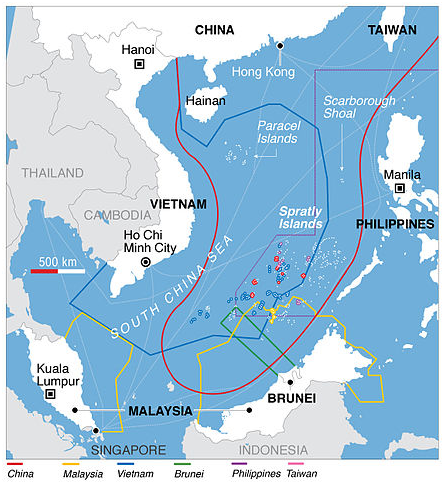President Obama's visit to Hiroshima, the city that was attacked by a U.S. atomic bomb at the end of world War II has prompted a new round of stories about nuclear tensions and nuclear disarmament. Today, I am going to blog about rising tensions between China and the U.S. and the deployment of nuclear weapons.
China has claimed a group of islands in the South China Sea. It has been dredging and adding soil to some of the islands and building military bases. The islands in question are called the Spratly Islands. They lie in overlapping territorial waters of The Philippines, Vietnam, Malaysia, Taiwan and Brunei and are close to major international shipping lanes. These six nations as well as the U.S. and other nations dispute the Chinese claims to these islands. The Paracel Islands and the Scarborough Shoal in the same area are also contested. The U.S. has been sending U.S. naval vessels to sail in this area as a counter to the claims of China.
Recently China has been talking about the need to deploy regular patrols of nuclear submarines with nuclear missiles in the Pacific Ocean as a response to new U.S. weapons systems that they claim have undermined China's existing deterrent force. Chinese concerns were raised when the U.S. announced in March that the U.S. was going to deploy the Thaad anti-ballistic missile defense system in South Korea. The U.S. said that the Thaad system was being planned as a response to recent nuclear tests and provocations from North Korea. However, China points out that the Thaad system could also be used against missiles in the South China Sea. They are also worried about U.S. work on hypersonic glide missiles that could reach China in less than one hour after they were launched.
China has been working on ballistic missile submarine technology for decades. Actual deployment in regular patrols has been delayed as a matter of policy, technical problems and rivalry between Chinese military institutions. Chinese nuclear warheads and the missiles that can deliver them have been stored separately up to this point. If the Chinese arm and deploy nuclear missile carrying submarines, this will be a major change of policy because the warheads and missiles would be together on the submarines. Previously, Chinese central command strictly controlled assembly and launch of nuclear missiles. With the missiles on the submarines, they could be launched much faster. The U.S. is concerned that such Chinese deployment will further destabilize the already tense situation in Southeast Asia.
China has four ballistic missiles submarines stationed at Hainan Island in the South China Sea. They are currently building a fifth. With tensions rising in the South China Sea because of the dispute over the Spratly Islands and other nearby other groups of islands, the Chinese recently announced plans to start regular patrols of the nuclear armed submarines in the area. With U.S. Navy sending Naval vessels to patrol in the same area, potential for confrontation is increasing. Recently a U.S. spy plane and two Chinese fighters almost collided in the air near Hainan Island.
